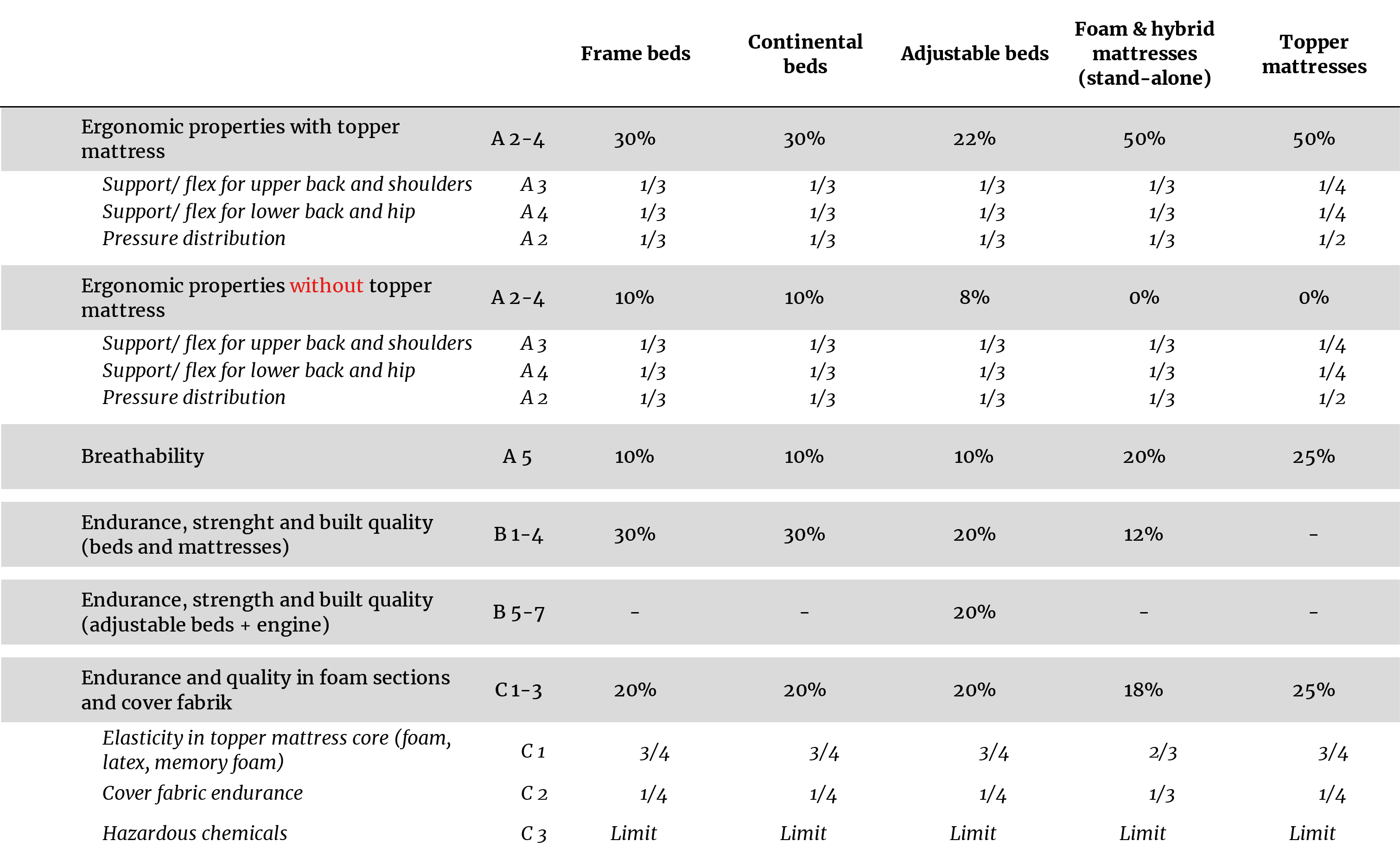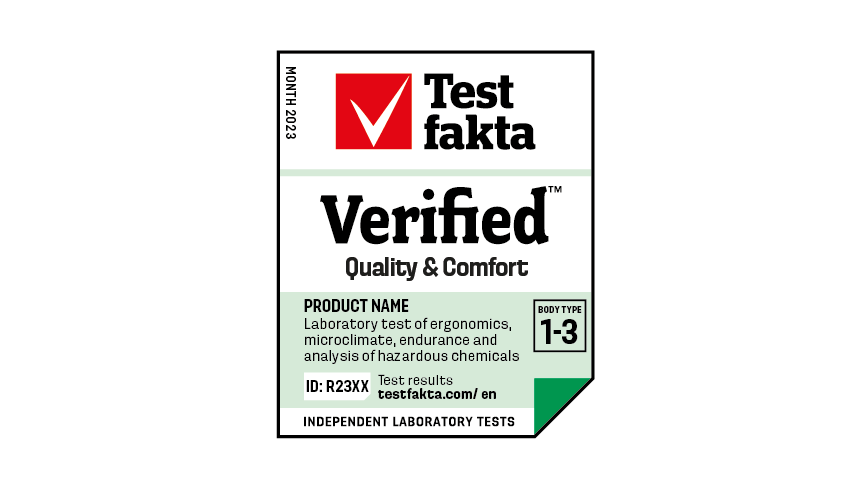How we test - Beds
Testfakta's tests of beds and mattresses are performed in different categories:
- Frame beds
- Continental beds
- Adjustable beds
- Frameless mattresses (mattresses for use without topper)
- Youth beds (10 - 15 years)
Benchmark tests are performed on medium-hard beds. The tests are made on beds with and without topper mattress, with the exception of free-standing mattresses that are tested with and without cover fabric.
The laboratory tests are performed by the EIM Ergonomics Institute Munich, RISE Research Institutes of Sweden and Swerea IVF. The tests include the main elements of ergonomics / comfort (EIM), endurance, strength and durability (RISE) and the textiles quality and harmful chemicals (Swerea IVF).
A. Tests for ergonomics/comfort (EIM)
1. Resilient properties (elastic properties)
2. Pressure distribution properties (contact pressure)
3. Elasticity of the bed and support for the shoulder portion
4. Elasticity and support of the bed for the body
5. Breathability (moisture conduction properties)
6. Heat-insulating properties
All parts except the A5 and A6 are carried out both with and without a mattress pad. Tests A3 and A4 are performed on three different body types: Smaller / lighter person corresponding to about 155 cm / 50-55 kg, medium / medium person corresponding to about 175 cm / 70-75 kg and larger / heavier person corresponding to about 185 cm / 85-90 kg.
A1
Elastic properties indicate how hard or soft the bed's suspension is and how the bed adapts to the body's most powerful (heaviest) contact points. The measurement is made in the bed's zones for shoulders, hip, lumbar spine and heels at three different pressures (100 N, 200 N and 300 N) and is given as an average value in mm flex.
A2
Pressure distribution properties indicate how the mattress surface reduces the pressure of a certain body part. This value can be attributed more to the mattress surface and the material directly below the surface than the bed springs. Measurements are taken in the bed’s zones for shoulders, hips, lower back and heels and are given as an average in Newton per cm2.
A3
Elasticity and support for the shoulder portion indicate how much the bed yields under the shoulder portion. At lateral position, the suspension under the shoulder portion should yield enough so that the shoulder is allowed to sink into the mattress and thereby contribute to the spine retaining a straight line between the lumbar spine and the neck. In the back position, the bed should provide sufficient support to prevent the shoulder portion / upper part of the back from sinking too far, thereby causing a bending of the upper part of the spine (neck). The test is performed with two different test stamps. One for back position with surface 400 x 200 mm and one for side position with surface 200 x 100 mm. The stamps are loaded with different pressures to simulate three different body types. 100 N for smaller / lighter person, 200 N for medium / medium person and 250 N for larger / heavier person. The measurement value is stated in mm flex.
A4
Elasticity and support for the body indicates the ability of the elastic to support the spine's natural s-shaped structure. In the back position, the pressure from the elastic should provide adequate support for the different parts of the body (support for the lumbar, flexibility / support for the pelvis / buttocks and shoulder portion) with the purpose of preserving the spine's natural contour. The test is performed with a test stamp designed as the body's contour from the butt up to the neck (length 600 mm and width about 250 mm with a lumbar depth of about 25 mm). The stamp is loaded with different pressures to simulate three different body types. 350 N for smaller / lighter person, 450 N for medium / medium person and 500 N for larger / heavier person. The measured value shows the support in the lumbar region and is indicated in Newton.
A5
The bed's breathability indicates the bed's ability to dissipate moisture / sweat from the body. Breathability is tested using a mannequin that secretes moisture / sweat as a normal person at sleep. The mannequin is placed under a standard cover and the measurements are made continuously for 7 hours at a room temperature of 21 degrees Celsius. The breathability is based on the measured value after 7 hours and is stated in percent relative humidity.
A6
The heat-insulating ability of the bed indicates the ability of the bed to retain heat from the body. The insulation ability is tested using a mannequin that maintains a body temperature corresponding to a normal person at sleep. The mannequin is placed under a standard cover and the measurements are made continuously for 7 hours at a room temperature of 21 degrees Celsius. The insulation capacity is based on the measured value after 7 hours and is given in degrees Celsius.
B. Tests for endurance, strength and built quality (RISE)
1. Endurance testing of suspension properties
2. Endurance testing of frame and bottom section
3. Endurance testing of the bedside
4. Impact testing of bed surface, frame and bottom section
Adjustable beds
5. Endurance testing of adjustable mechanism and motors
6. Static load in raised position
7. Impact testing in raised position
Endurance and impact testing (B1 - B4) is performed with the same load and with the same number of cycles regardless of the type of bed. Test B5 - B7 refers only to adjustable beds. Freestanding mattresses undergo only the endurance tests (B1 - B3).
B1
Endurance of the suspension properties is tested by exposing the beds to 30,000 rolls of 140 kg drum. The endurance test corresponds to the impact from 10 - 12 years of normal use.
B2
Endurance of bed surface, frame and bottom section is tested by exposing the beds to 20,000 pressures with a force of 1000 Newton. The pressure load is made in the middle of the bed and at the bed's short and long side. After endurance testing measurements of the height loss (set in mm) and changes in bed hardness index (suspension properties on a 10-degree scale) are made.
B3
Bed side endurance testing is tested by exposing the two long sides of the bed to 25,000 pressures with a load of 1,000 Newton. The test simulates the stress that the bed is exposed to when sitting on the edge. After endurance testing of the bed side, measurements of height loss (setting) are made on the sides of the bed.
B4
Impact testing of bed surface, frame and bottom section simulates higher stresses that occur when, for example, children jump in bed. In the test, a weight of 35 kg is released from 30 cm height in 6 different places in the bed and 10 times in each place. After completion of the endurance and strength test, the beds are opened and inspected for possible damage to springs, pockets, intermediate layers (foam layers over spring packs), bed frames or bottom ribs.
B5 – B7 (adjustable beds)
-
The head end is raised 15 cm and the foot end 10 cm. Static load of 90 kg for 10 seconds. 10 times for each corner + 10 times in the "knee joint". The load is made 20 cm diagonally in from each corner + 20 cm in from the respective long side in the "knee joint". Static load corresponds to the load of a heavier person sitting in bed.
-
Edge testing (90 kg) at the same points as the static load (500 pressure in each corner + 500 pressure in each side of the "knee joint"). Load corresponding to a person of 90 kg who sits on the bed.
-
Function check after completed test of bed.
-
Endurance test where the bed is raised and lowered in the head and foot ends 1,000 times. The bed is loaded corresponding to a person weighing 120 kg.
-
Repeat of static load, edge testing and subsequent function check.
Note that the test method for adjustable beds will be updated in 2022. The purpose is to add a measuring method for ergonomics in upright position. More information to follow.
C. Topper and foam mattress testing (RISE & Swerea)
1. Compression test in humid environment of the topper core (foam)
2. Durability of the cover fabric (peeling and linting)
3. Hazardous chemicals (relevant parameters from Öko-tex 100)
C1
The elasticity of the bed mattress core (foam) is tested according to the same method regardless of type (latex, cold foam or memory foam). The bed mattress core (foam material) is compressed in a humid and warm environment to simulate the pressure of a person lying in bed in warm conditons. The resilience and endurance testing is carried out on a 10 x 10 cm test pieces of the bed mattress core. The test pieces are pressed together in the middle with a load of 7 kg, which corresponds to the hip bone pressure on a surface of 5 x 5 cm. The compressed specimens are placed in a climate chamber with a relative humidity of 90% (+/- 2%) for 24 hours. After compression, the material is allowed to recover for 30 minutes. The difference in height before and after compression shows the material's endurance / resilience. Inferior foam material gets a permanent set after the compression test and loses its resilience. The test is based on test standard ISO 1856 (Wet Compression Set).
C2
The durability of the cover fabric (peeling and linting). The cover fabric is exposed to abrasion testing up to 5,000 cycles to evaluate resistance to peeling and linting.
C3
Analysis of hazardous chemicals. Chemical analysis for hazardous substances based on relevant parts from OEKO-Tex 100.
Grading and weighting of the test results
The results from the various parts of the test are graded on a scale of 1 - 10 where 10.0 is best and 6.0 approved/ acceptable. Grading and weighting of the various sub-results is done in consultation with the performing laboratories. The grades for the various parts of the test are weighted together to form a total grade as follows:

Verification test (Verified Quality & Comfort)

The beds are verified for three different body types:
-
TYPE 1: smaller / lighter people (approx. 155 cm and 50 -55 kg)
-
TYPE 2: medium / medium-heavy persons (approx. 175 cm and 70-75 kg)
-
TYPE 3: larger / heavier people (about 185 cm and 85-90 kg).
Youth beds are only verified for smaller / lighter persons (approx. 155 cm and 50 - 55 kg). To meet the criteria for Test Facts Verified Quality & Comfort:
-
Approved results from analysis of hazardous chemicals
-
Total grades (sections A, B and C) of at least 8.0.
-
Rating for ergonomic properties with topper (sections A1 - A4) of at least 8.0.
-
Breathability rating of at least 6.0
-
Grades for endurance, strength and built quality (section B) of at least 6.0
-
Rating for topper properties (section C) of at least 6.0
All grades with 5% error margin.
The verification is done per type of body size (TYP1, TYP2 and TYP3). The total grade is based on the test result for ergonomics (A3 + A4) for each respective body size.
